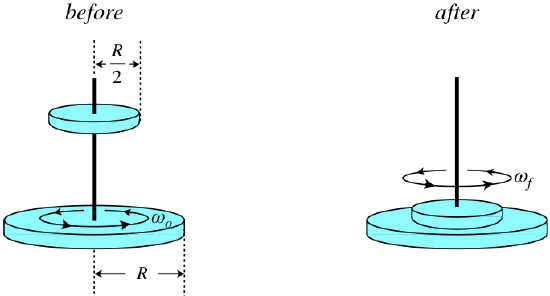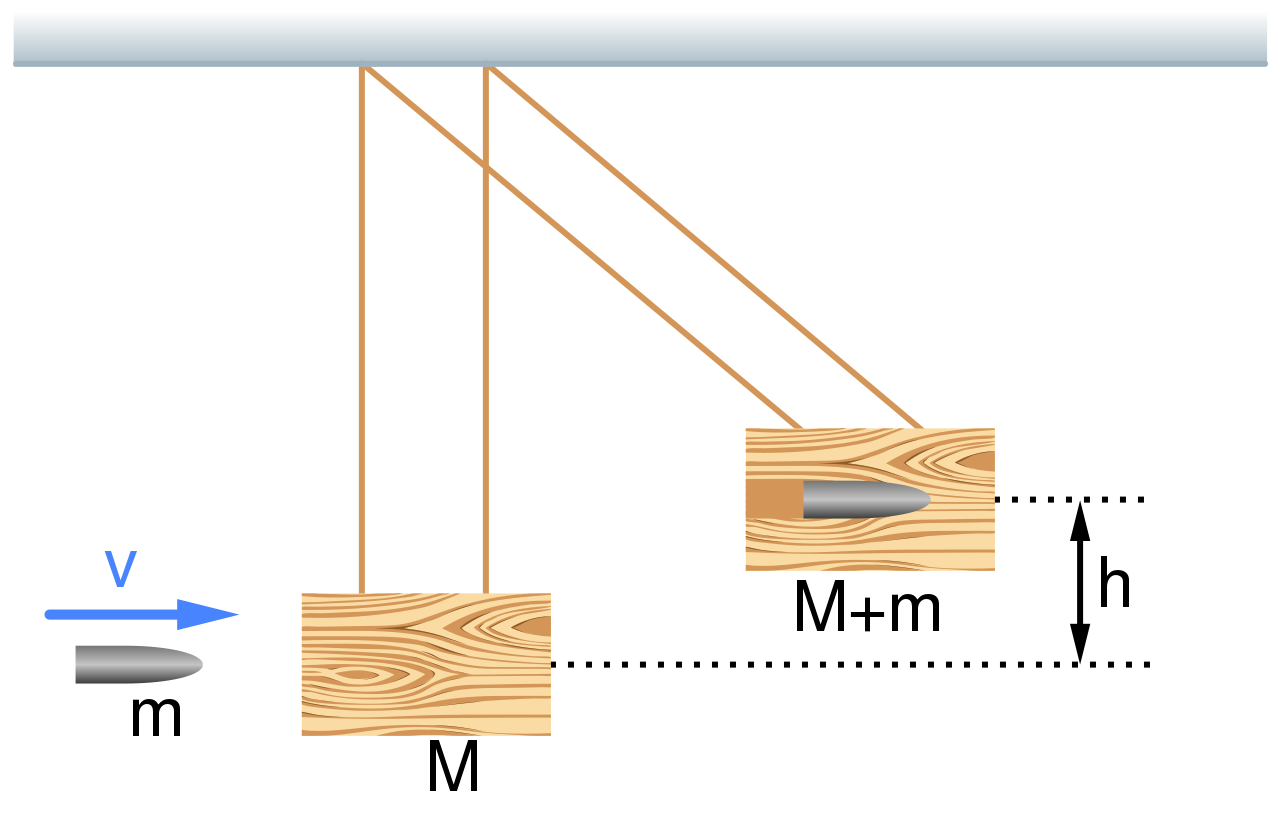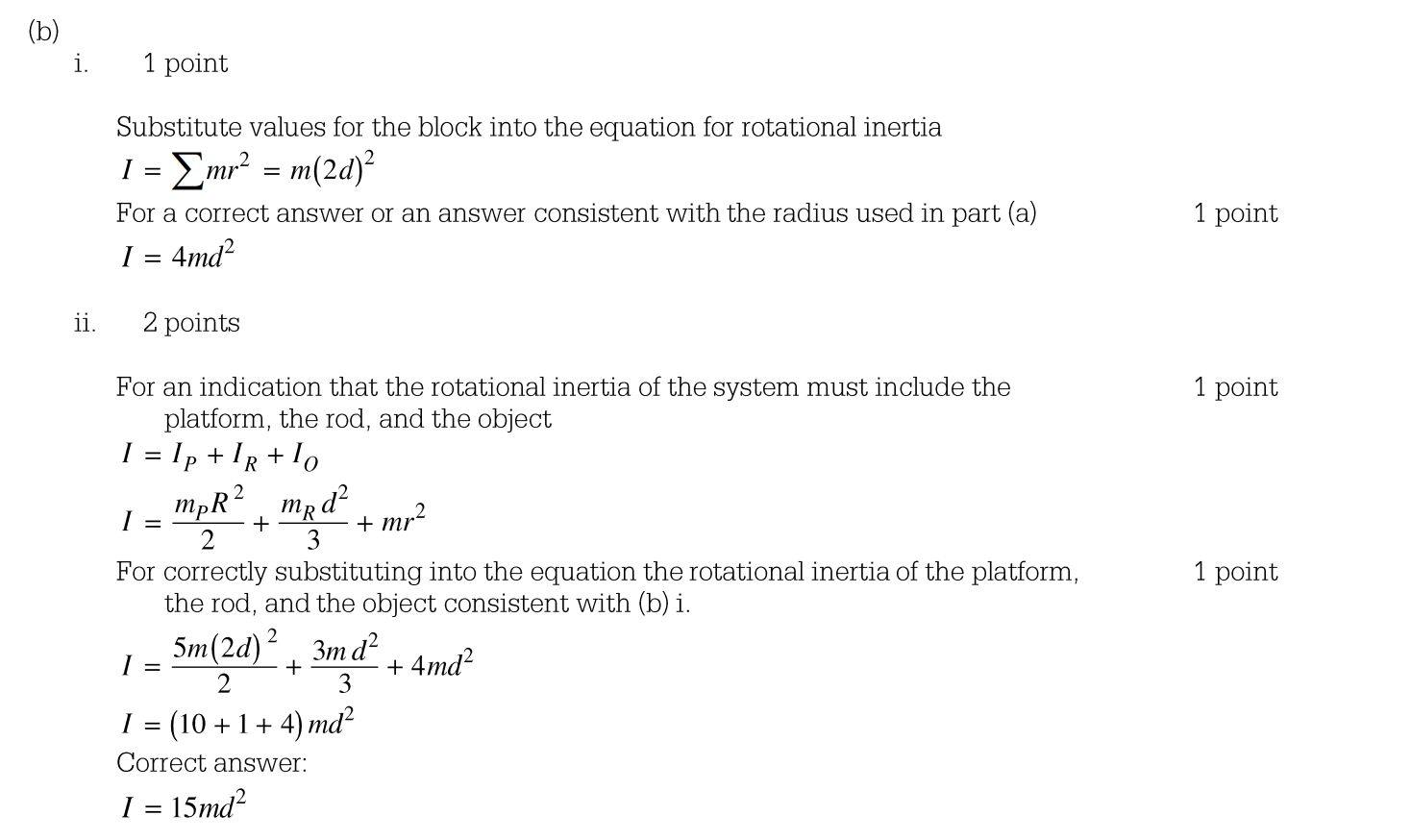
5.4 Angular Momentum and Its Conservation
3 min read•january 29, 2023
Daniella Garcia-Loos
Daniella Garcia-Loos
Conservation of Angular Momentum
Angular momentum is a measure of an object's rotation around an axis, and is given by the product of the object's moment of inertia and its .
The total angular momentum of a system of objects is the sum of the angular momenta of the individual objects.
In an isolated system, the total angular momentum is conserved, meaning that it remains constant over time.
This means that if an is applied to an object, causing its to change, the angular momentum will remain constant, provided that no external torques are acting on the object.
Similarly, if an is applied to an object, causing its moment of inertia to change, the will change such that the angular momentum remains constant.
is used to explain phenomena such as the stability of planets and stars, the precession of a spinning top, and the behavior of spinning objects in the presence of external forces.
can be applied to both and , as long as the body remains in a rigid state and the external torques acting on the body are not too large.
Which means that torque is the slope of an angular momentum vs. time graph!
⚠️ Common misconception: You cannot just multiply r by translational momentum to change it to angular!! L does not equal mvr for anything other than a point/particle!
Common Situations of Conservation of Angular Momentum
Disks Colliding:
This situation is extremely similar to pool ball scenarios we've seen in the past with linear momentum, however, we typically considered those pool balls as a particle/point in space. Disks have some so they can apply torque on each other. However, it is important to remember that angular momentum is conserved because these torques are inside the system!
Here's an example of a disk collision below:

Taken from LibreTexts
Ballistic Pendulum:
A is a device used to measure the speed of a projectile, such as a bullet. To solve a problem, you will need to know the initial speed of the projectile and the mass of the pendulum. You can then use the conservation of energy and the conservation of momentum to calculate the final speed of the projectile and the maximum height of the pendulum's swing. Here are the steps to solve a problem:
Identify the initial and final states of the system. In this case, the initial state is the bullet moving with a certain velocity and the pendulum at rest, while the final state is the bullet embedded in the pendulum, which is swinging at some height.
Use the conservation of energy to find the maximum height of the pendulum's swing. The initial of the bullet is equal to the final of the pendulum.
Use the conservation of momentum to find the final velocity of the bullet. The initial momentum of the bullet is equal to the final momentum of the bullet and pendulum combined.
Once you have the final velocity and the mass of the pendulum, you can use the equation for to find the speed of the bullet.
Remember that the final velocity of the bullet is very small compare to the initial velocity, and assuming the pendulum is much heavier than the bullet, to get a more accurate result you can use the conservation of energy and momentum equations for a system of two masses (bullet+pendulum)
You can see an example of the scenario below:

Taken from Wikimedia Commons
Typically it can be solved with a combination of conservation of energy and momentum! When the pendulum has some , we have to use conservation angular momentum for the bullet-pendulum system.
Satellites:
We'll cover this situation in Unit 7, but just know it exists!
Practice Questions:
1)

Answer:

2)

Answer:

3)

Answer:

4)

Answer:

Key Terms to Review (10)
Angular velocity
: Angular velocity refers to the rate at which an object rotates around a fixed axis. It is measured in radians per second and represents how quickly an object is spinning.Ballistic Pendulum
: A ballistic pendulum is a device used to measure the speed of a projectile by capturing it in a pendulum and measuring the height it reaches.Conservation of Angular Momentum
: The conservation of angular momentum states that the total angular momentum of a system remains constant if no external torques act on it. In other words, the rotational motion of an object will not change unless an external torque is applied.Disks Colliding
: Disks colliding refers to the scenario where two circular disks come into contact with each other and exchange momentum and energy through collision.External Torque
: External torque refers to the rotational force applied to an object by an external agent, causing it to rotate around a fixed axis. It is the net torque acting on an object due to forces external to the system.Gravitational Potential Energy
: Gravitational potential energy is the energy possessed by an object due to its position in a gravitational field. It represents the work done to move the object from a reference point (usually at infinity) to its current position.Kinetic energy
: Kinetic energy is the energy possessed by an object due to its motion. It depends on both the mass and velocity of the object.Non-rigid bodies
: Non-rigid bodies are objects that can change their shape when subjected to external forces. They do not maintain a fixed shape or size.Rigid bodies
: Rigid bodies are objects that do not deform under applied forces; their shape remains constant even when subjected to external forces or torques.Rotational inertia
: Rotational inertia (also known as moment of inertia) is a measure of an object's resistance to changes in rotational motion. It depends on both the mass distribution within an object and how it is rotating about an axis.5.4 Angular Momentum and Its Conservation
3 min read•january 29, 2023
Daniella Garcia-Loos
Daniella Garcia-Loos
Conservation of Angular Momentum
Angular momentum is a measure of an object's rotation around an axis, and is given by the product of the object's moment of inertia and its .
The total angular momentum of a system of objects is the sum of the angular momenta of the individual objects.
In an isolated system, the total angular momentum is conserved, meaning that it remains constant over time.
This means that if an is applied to an object, causing its to change, the angular momentum will remain constant, provided that no external torques are acting on the object.
Similarly, if an is applied to an object, causing its moment of inertia to change, the will change such that the angular momentum remains constant.
is used to explain phenomena such as the stability of planets and stars, the precession of a spinning top, and the behavior of spinning objects in the presence of external forces.
can be applied to both and , as long as the body remains in a rigid state and the external torques acting on the body are not too large.
Which means that torque is the slope of an angular momentum vs. time graph!
⚠️ Common misconception: You cannot just multiply r by translational momentum to change it to angular!! L does not equal mvr for anything other than a point/particle!
Common Situations of Conservation of Angular Momentum
Disks Colliding:
This situation is extremely similar to pool ball scenarios we've seen in the past with linear momentum, however, we typically considered those pool balls as a particle/point in space. Disks have some so they can apply torque on each other. However, it is important to remember that angular momentum is conserved because these torques are inside the system!
Here's an example of a disk collision below:

Taken from LibreTexts
Ballistic Pendulum:
A is a device used to measure the speed of a projectile, such as a bullet. To solve a problem, you will need to know the initial speed of the projectile and the mass of the pendulum. You can then use the conservation of energy and the conservation of momentum to calculate the final speed of the projectile and the maximum height of the pendulum's swing. Here are the steps to solve a problem:
Identify the initial and final states of the system. In this case, the initial state is the bullet moving with a certain velocity and the pendulum at rest, while the final state is the bullet embedded in the pendulum, which is swinging at some height.
Use the conservation of energy to find the maximum height of the pendulum's swing. The initial of the bullet is equal to the final of the pendulum.
Use the conservation of momentum to find the final velocity of the bullet. The initial momentum of the bullet is equal to the final momentum of the bullet and pendulum combined.
Once you have the final velocity and the mass of the pendulum, you can use the equation for to find the speed of the bullet.
Remember that the final velocity of the bullet is very small compare to the initial velocity, and assuming the pendulum is much heavier than the bullet, to get a more accurate result you can use the conservation of energy and momentum equations for a system of two masses (bullet+pendulum)
You can see an example of the scenario below:

Taken from Wikimedia Commons
Typically it can be solved with a combination of conservation of energy and momentum! When the pendulum has some , we have to use conservation angular momentum for the bullet-pendulum system.
Satellites:
We'll cover this situation in Unit 7, but just know it exists!
Practice Questions:
1)

Answer:

2)

Answer:

3)

Answer:

4)

Answer:

Key Terms to Review (10)
Angular velocity
: Angular velocity refers to the rate at which an object rotates around a fixed axis. It is measured in radians per second and represents how quickly an object is spinning.Ballistic Pendulum
: A ballistic pendulum is a device used to measure the speed of a projectile by capturing it in a pendulum and measuring the height it reaches.Conservation of Angular Momentum
: The conservation of angular momentum states that the total angular momentum of a system remains constant if no external torques act on it. In other words, the rotational motion of an object will not change unless an external torque is applied.Disks Colliding
: Disks colliding refers to the scenario where two circular disks come into contact with each other and exchange momentum and energy through collision.External Torque
: External torque refers to the rotational force applied to an object by an external agent, causing it to rotate around a fixed axis. It is the net torque acting on an object due to forces external to the system.Gravitational Potential Energy
: Gravitational potential energy is the energy possessed by an object due to its position in a gravitational field. It represents the work done to move the object from a reference point (usually at infinity) to its current position.Kinetic energy
: Kinetic energy is the energy possessed by an object due to its motion. It depends on both the mass and velocity of the object.Non-rigid bodies
: Non-rigid bodies are objects that can change their shape when subjected to external forces. They do not maintain a fixed shape or size.Rigid bodies
: Rigid bodies are objects that do not deform under applied forces; their shape remains constant even when subjected to external forces or torques.Rotational inertia
: Rotational inertia (also known as moment of inertia) is a measure of an object's resistance to changes in rotational motion. It depends on both the mass distribution within an object and how it is rotating about an axis.
Resources
© 2024 Fiveable Inc. All rights reserved.
AP® and SAT® are trademarks registered by the College Board, which is not affiliated with, and does not endorse this website.